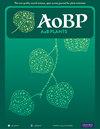Akabare辣椒地方品种对单独和组合干旱和热胁迫的生理反应评价和抗逆性鉴定
IF 2.4
3区 生物学
Q2 ECOLOGY
引用次数: 0
摘要
Akabare辣椒(Capsicum annuum L.)为尼泊尔农村生计做出了贡献,但由于干旱和高温等各种非生物胁迫,其生产力低下。本研究旨在评估赤豆辣椒地方品种对高温和干旱胁迫的生理反应,并鉴定营养早期的抗逆性基因型。选择8个Akabare地方辣椒品种和辣椒品种Jwala,分别在控制(30/22°C昼夜)和热胁迫(40/32°C)条件下进行灌溉,干旱胁迫(30/22°C)和干热联合胁迫条件下不灌溉7天,然后在控制条件下恢复5天。在胁迫条件下,抗逆性地方品种在PSⅱ(Fv/Fm)、蒸腾速率(E)、净光合速率(PN)、气孔导度(gs)、叶温降(LTD)、水分利用效率(WUE)和气孔面积比(PASA)等指标上均优于敏感性地方品种,从而提高了生物量。虽然所有基因型在对照条件下表现相似,但在热胁迫下Fv/Fm、PN、E、gs和WUE的响应显著降低,在干旱胁迫下进一步降低,在两者联合作用下严重下降。与对照相比,综合胁迫导致总生物量减少57.48%,其次是干旱(37.8%)和高温(21.4%)。在各地方品种中,C44的生物量增幅最大(35%),DKT77次之(33.48%),而C64C和PPR77的生物量增幅最低(29%)。耐受性地方品种的叶片冷却率、叶绿素含量和叶片相对含水量也较高,气孔较少,气孔开口较大。该研究确定了潜在的抗逆性Akabare辣椒地方品种,并讨论了在变化的气候条件下开发抗逆性作物品种的抗逆性生理机制。本文章由计算机程序翻译,如有差异,请以英文原文为准。
Evaluating the physiological responses and identifying stress-tolerance of Akabare chili landraces to individual and combined drought and heat stresses
Akabare chili (Capsicum annuum L.) contributes to Nepalese rural livelihoods but suffers from low productivity due to various abiotic stresses including drought and heat. This study aimed to assess the physiological responses of Akabare chili landraces to heat and drought stress, individually and together, and to identify stress-tolerant genotypes in the early vegetative stage. Selected eight Akabare chili landraces and chili variety ‘Jwala’ were subjected to control (30/22°C day/night) and heat stress (40/32°C) conditions with irrigation, and drought stress (30/22°C) and combined drought-heat stress conditions without irrigation for seven days, followed by a five-day recovery under control condition. Stress-tolerant landraces showed better performance compared to sensitive ones in terms of efficacy of PS II (Fv/Fm), transpiration rate (E), net photosynthetic rate (PN), stomatal conductance (gs), leaf temperature depression (LTD), water use efficiency (WUE), and the ratio of stomata pore area to stomata area (PASA) under stress conditions, resulting in improved biomass. Although all genotypes performed statistically similar under control conditions, their responses Fv/Fm, PN, E, gs, and WUE were significantly reduced under thermal stress, further reduced under drought stress, and severely declined under the combination of both. Total biomass exhibited a 57.48% reduction due to combined stress, followed by drought (37.8%) and heat (21.4%) compared to the control. Among the landraces, C44 showed the most significant gain in biomass (35%), followed by DKT77 (33.48%), while the lowest gain percentage was observed for C64C and PPR77 during the recovery phase (29%). The tolerant landraces also showed a higher percentage of leaf cooling, chlorophyll content, and leaf relative water content with fewer stomata but broader openings of pores. The study identifies potential stress-tolerant Akabare chili landraces and discusses the stress-tolerant physiological mechanisms to develop resilient crop varieties in changing climates.
求助全文
通过发布文献求助,成功后即可免费获取论文全文。
去求助
来源期刊

AoB Plants
PLANT SCIENCES-
CiteScore
4.80
自引率
0.00%
发文量
54
审稿时长
20 weeks
期刊介绍:
AoB PLANTS is an open-access, online journal that has been publishing peer-reviewed articles since 2010, with an emphasis on all aspects of environmental and evolutionary plant biology. Published by Oxford University Press, this journal is dedicated to rapid publication of research articles, reviews, commentaries and short communications. The taxonomic scope of the journal spans the full gamut of vascular and non-vascular plants, as well as other taxa that impact these organisms. AoB PLANTS provides a fast-track pathway for publishing high-quality research in an open-access environment, where papers are available online to anyone, anywhere free of charge.
 求助内容:
求助内容: 应助结果提醒方式:
应助结果提醒方式:


